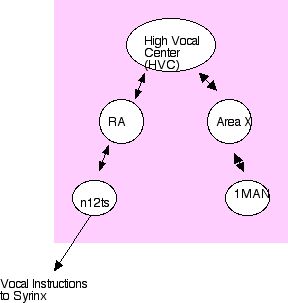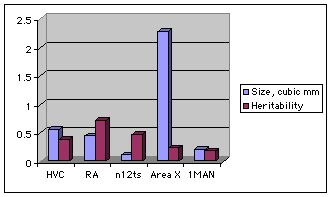
Calculation of the heritability of size of structures within the nervous system shows which structures have been under stronger selection in the species' evolutionary history, and which have retained additive genetic variation. Songbirds, such as the zebra finch, Taeniopygia guttata, provide particulary interesting results, as their relatively complex songs are, in part, learned. Airey et al. (2000) investigated the heritability of size of vocal centers in the brains of zebra finches. Two major pathways, one for song learning and the other for song production (figure 1) show differences in heritability of their components (figure 2). Airey et al.'s results suggest that song learning has been under stronger selection in the past (lower heritability), and that the potential exists for evolving more complex songs in the future, as zebra finches have retained additive genetic variation (higher heritability) of the song production centers.

Figure 1. Simplified diagram (after Airey et al. 2000) of the vocal pathways in songbirds. The righthand pathway is critical to song learning, the left to song production; both pathways interact with the High Vocal Center (HVC). Centers in the pink area are inside the brain.

Figure 2. Sizes and their heritabilities of centers in the vocal pathway of the zebra finch (data from Airey et al. 2000). The highest heritabilities are found in the sound production pathway (RA, n12ts) and the lowest in the sound learning pathway (Area X, 1MAN).
Airey D. C., Castillo-Juarez H., Casella G., Pollak E. J., DeVoogd T. J. 2000. Variation in the volume of zebra finch song control nuclei is heritable: developmental and evolutionary implications. Proceedings of the Royal Society Of London series b-biological sciences 267:2099-2104
page 4-1
copyright ©2001 Michael D. Breed, all rights reserved